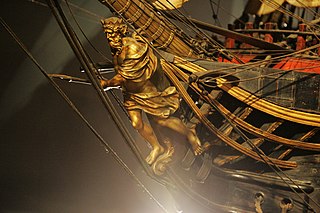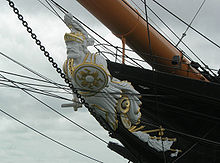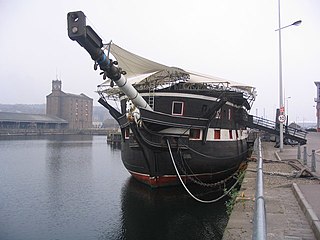
A figurehead is a carved wooden decoration found at the bow of ships, generally of a design related to the name or role of a ship. They were predominant between the 16th and 20th centuries, and modern ships' badges fulfil a similar role.

A figurehead is a carved wooden decoration found at the bow of ships, generally of a design related to the name or role of a ship. They were predominant between the 16th and 20th centuries, and modern ships' badges fulfil a similar role.

Although earlier ships had often had some form of bow ornamentation (e.g. the eyes painted on the bows of Greek and Phoenician galleys, the Roman practice of putting carvings of their deities on the bows of their galleys, and the Viking ships of ca. A.D. 800–1100), the general practice was introduced with the galleons of the 16th century, as the figurehead as such could not come to be until ships had an actual stemhead structure on which to place it. [1] The menacing appearance of toothy and bug-eyed figureheads on Viking ships were considered a form of apotropaic magic, serving the function of warding off evil spirits. [2] The Egyptians placed figures of holy birds on the prow while the Phoenicians used horses representing speed. The Ancient Greeks used boars' heads to symbolise acute vision and ferocity while Roman boats often mounted a carving of a centurion representing valour in battle. In northern Europe, serpents, bulls, dolphins and dragons were customary and by the 13th century, the swan was used representing grace and mobility. [3]

In Germany, Belgium and the Netherlands, it was once believed that spirits/faeries called Kaboutermannekes (gnomes, little men, faeries) dwelt in the figureheads. The spirit guarded the ship from sickness, rocks, storms, and dangerous winds. If the ship sank, the Kaboutermannekes guided the sailors' souls to the Land of the Dead. To sink without a Kaboutermanneke condemned the sailor's soul to haunt the sea forever, so Dutch sailors believed. A similar belief was found in early Scandinavia.[ citation needed ]
In pre-colonial Burma, during the Konbaung dynasty, figureheads were used to distinguish several types of royal barges allocated to different members of the royal court; each barge had a specific mythical figurehead at the front.
During the period from the 17th to the 18th centuries the carved subjects of figureheads varied from representations of saints to patriotic emblems such as the unicorns or lions popular on British ships. When the ship was named after a royal or naval personage the head and bust of the individual might be shown. [4]
As with the stern ornamentation, the purpose of the figurehead was often to indicate the name of the ship in a non-literate society (albeit in a sometimes very convoluted manner); and always, in the case of naval ships, to demonstrate the wealth and might of the owner. At the height of the Baroque period, some ships boasted gigantic figureheads, weighing several tons and sometimes twinned on both sides of the bowsprit.[ citation needed ]
A large figurehead, being carved from massive wood and perched on the very foremost tip of the hull, adversely affected the sailing qualities of the ship. This, and cost considerations, led to figureheads being made dramatically smaller during the 18th century, and in some cases they were abolished altogether around 1800. After the Napoleonic wars they made something of a comeback, but were then often in the form of a small waist-up bust rather than the oversized full figures previously used. The clipper ships of the 1850s and 1860s customarily had full figureheads, but these were relatively small and light. During their final stage of common usage figureheads ranged in length from about 18 inches (46 cm) to 9 feet (2.7 m). [5]
This section needs additional citations for verification .(November 2017) |



Figureheads as such died out with the military sailing ship. In addition the vogue for ram bows meant that there was no obvious place to mount one on battleships. [6] An exception was HMS Rodney which was the last British battleship to carry a figurehead. [6] Smaller ships of the Royal Navy continued to carry them. The last example may well have been the sloop HMS Cadmus launched in 1903. [7] Her sister ship Espiegle was the last to sport a figurehead till her breaking up in 1923. Early steamships sometimes had gilt scroll-work and coats-of-arms at their |bows. This practice lasted up until about World War I. The 1910 German liner SS Imperator originally sported a large bronze figurehead of an eagle (the Imperial German symbol) standing on a globe. The few extra feet of length added by the figurehead made Imperator the longest ship in the world at the time of her launch.
It is still common practise for warships to carry ships' badges, large plaques mounted on the superstructure with a unique design relating to the ship's name or role. For example, Type 42 destroyers of the Royal Navy, which are named after British cities, carry badges depicting the coat of arms of their namesake.
On smaller vessels, a billethead might be substituted. This was a smaller, nonfigural carving, most often a curl of foliage. [8] [9]


A gunboat is a naval watercraft designed for the express purpose of carrying one or more guns to bombard coastal targets, as opposed to those military craft designed for naval warfare, or for ferrying troops or supplies.

A hulk is a ship that is afloat, but incapable of going to sea. Hulk may be used to describe a ship that has been launched but not completed, an abandoned wreck or shell, or to refer to a ship whose propulsion system is no longer maintained, or has been removed altogether. The word hulk also may be used as a verb: a ship is "hulked" to convert it to a hulk. The verb was also applied to crews of Royal Navy ships in dock, who were sent to the receiving ship for accommodation, or "hulked". Hulks have a variety of uses such as housing, prisons, salvage pontoons, gambling sites, naval training, or cargo storage.

HMS Hibernia was a 110-gun first-rate ship of the line of the Royal Navy. She was launched at Plymouth dockyard on 17 November 1804, and was the only ship built to her draught, designed by Sir John Henslow.

In sailing vessels, the head is the ship's toilet. The name derives from sailing ships in which the toilet area for the regular sailors was placed at the head or bow of the vessel.

Viking art, also known commonly as Norse art, is a term widely accepted for the art of Scandinavian Norsemen and Viking settlements further afield—particularly in the British Isles and Iceland—during the Viking Age of the 8th-11th centuries. Viking art has many design elements in common with Celtic, Germanic, the later Romanesque and Eastern European art, sharing many influences with each of these traditions.

Slave ships were large cargo ships specially built or converted from the 17th to the 19th century for transporting slaves. Such ships were also known as "Guineamen" because the trade involved human trafficking to and from the Guinea coast in West Africa.

HMSUnicorn is a surviving sailing frigate of the successful Leda class, although the original design had been modified by the time that the Unicorn was built, to incorporate a circular stern and "small-timber" system of construction. Listed as part of the National Historic Fleet, Unicorn is now a museum ship in Dundee, Scotland, United Kingdom. She is the oldest ship in Scotland, one of the oldest ships in the world, and one of the last intact warships from the age of sail.

Blackwall frigate was the colloquial name for a type of three-masted full-rigged ship built between the late 1830s and the mid-1870s.

Naval heraldry is a form of identification used by naval vessels from the end of the 19th century onwards, after distinguishing features such as figureheads and gilding were discouraged or banned by several navies.
HMS Lyme was a 28-gun, sixth-rate frigate of the Royal Navy. Originally ordered as a 24 gun ship to the draft of the French privateer Tyger. The sixth vessel of the Royal Navy to bear the name, Lyme, as well as Unicorn, which was a near-sister, were the first true frigates built for the Royal Navy. They were actually completed with 28 guns including the four smaller weapons on the quarterdeck, but the latter were not included in the ship's official establishment until 22 September 1756. The two ships differed in detail, Unicorn having a beakhead bow, a unicorn figurehead, two-light quarter galleries and only five pairs of quarterdeck gunports, while Lyme had a round bow, a lion figurehead, three-light quarter galleries and six pairs of quarterdeck gunports.
HMS Unicorn was a 28-gun Lyme-class sixth-rate frigate of the Royal Navy. She was originally ordered as a 24-gun ship to the draft of the French privateer Tyger. The third vessel of the Royal Navy to bear the name, Unicorn, as well as HMS Lyme which was a near-sister, were the first true frigates built for the Royal Navy. They were actually completed with 28 guns including the four smaller weapons on the quarterdeck, but the latter were not included in the ship's official establishment until 22 September 1756. The two ships differed in detail, Unicorn having a beakhead bow, a unicorn figurehead, two-light quarter galleries, and only five pairs of quarterdeck gunports, while Lyme had a round bow, a lion figurehead, three-light quarter galleries, and six pairs of quarterdeck gunports.

James Baines was a passenger clipper ship completely constructed of timber in the 1850s and launched on 25 July 1854 from the East Boston shipyard of the famous ship builder Donald McKay in the United States for the Black Ball Line of James Baines & Co., Liverpool. The clipper was one of the few known larger sailing ships rigged with a moonsail.

There are many customs and traditions associated with the Royal Navy of the United Kingdom. Many of these traditions have carried on to other Commonwealth navies, such as Canada, India, Australia and New Zealand. These include formal customs such as separate crests associated with ships, ensigns and fleet reviews. There are also several less formal customs and traditions, including Naval slang commonly referred to as Jack Speak and the traditional games of Uckers and Euchre.

The Tamkang University Maritime Museum is a museum on sea navigation located on the campus of Tamkang University in Tamsui District, New Taipei City in Taiwan. The museum is located in a ship-like formed building which formerly served as a training center for future sailors on trading ships.

A sailor cap is a round, flat visorless hat worn by sailors in many of the world's navies. A tally, an inscribed black silk ribbon, is tied around the base which usually bears the name of a ship or a navy. Many navies tie the tally at the rear of the cap and let the two ends hang down to the shoulders as decorative streamers. In the Royal Navy the tally is tied off in a bow over the left ear and in the early 20th century it was customary when going on shore leave to tie a small coin in the bow to make it stand out. In wartime, as a security measure, many navies replace the name of the ship with a generic title. The cap may be further embellished with a badge, cockade or other accessory. Visorless caps of this kind began to be worn in the mid 19th century.

HMCS Unicorn is a Canadian Forces Naval Reserve division (NRD) located in Saskatoon, Saskatchewan. Dubbed a stone frigate, Unicorn is a land-based naval training establishment crewed by part-time sailors and also serves as a local recruitment centre for the Royal Canadian Navy (RCN). It is one of 24 naval reserve divisions located in major cities across Canada.

The Blue Jacket was an 1854 medium clipper well known for the lavish decoration of the staterooms and saloon. She served in the Liverpool and Australia trades. The ship was named after the blue jackets, a traditional name for sailors in the US and British navies.

Sunny South, an extreme clipper, was the only full-sized sailing ship built by George Steers, and resembled his famous sailing yacht America, with long sharp entrance lines and a slightly concave bow. Initially, she sailed in the California and Brazil trades. Sold in 1859 and renamed Emanuela, she was considered to be the fastest slaver sailing out of Havana. The British Royal Navy captured Emanuela off the coast of Africa in 1860 with over 800 slaves aboard. The Royal Navy purchased her as a prize and converted her into a Royal Navy store ship, Enchantress. She was wrecked in the Mozambique Channel in 1861.

The action of 14 June 1742 was a minor naval battle of the War of the Austrian Succession in which a small British squadron under Captain Richard Norris burned 5 Spanish royal galleys at the French port of Saint Tropez. Norris had surprised the galleys near Sainte-Marguerite and had chased and driven them into the French port. The British captain, in spite of alleged French neutrality, followed the Spanish vessels into the port and destroyed them at slight cost.

Joseph Marshall was an 18th-century British marine painter. He is best known as the painter of a series of paintings of ship models, commissioned by George III of Great Britain in 1773 but only completed in 1779. He worked from the ships' plans rather than models to produce bow and stern images of ten ships, representing every class in the Royal Navy at that time. These ten ships were HMS Ambuscade, Portland, Sphinx, Kingfisher, Barfleur, Royal George, Enterprise, Experiment, Royal Oak, and Intrepid. He had previously produced two similar paintings of Alert in 1755.